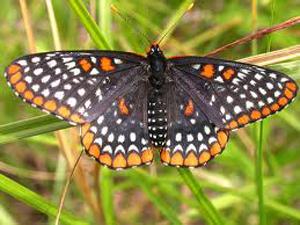
Baltimore Checkerspot
COLLEGE PARK- Climate change has become synonymous with melting glaciers and blazing summer months, but there is one very small casualty of global warming that isn’t front page news: butterflies.
Unpredictable and shifting climates are forcing butterflies around the world to change the time they emerge from their chrysalises, when and where they move, and even shift the range in which they travel.
“Climate change is definitely affecting butterflies on a vast scale,” said Jeffrey Glassberg, president of the North American Butterfly Association. “There’s a whole suite of butterflies whose ranges are retreating. Butterflies that used to be found in New Jersey and Massachusetts haven’t been seen in years.”
This could potentially hit Maryland especially hard; the state insect is a rare butterfly called the Baltimore Checkerspot. Thanks to habitat destruction and warming climates, the butterflies are in danger of being forced to pack their bags and move north.
The Baltimore Checkerspot has been Maryland’s state insect since 1973 and, much like bees, they pollinate a number of crops and wild flora throughout the state. At one point, Baltimore Checkerspots could be found statewide.
“They were all over Maryland, from the western to the easternmost counties,” said Jennifer Frye, the invertebrate ecologist for the state’s Wildlife and Heritage Service. “Now they’re in seven counties, less than 15 sites.”
Sites generally refer to breeding colonies in a wetland where the Baltimore Checkerspot’s host plant—the white turtlehead—is found, Frye explained. While caterpillars can transition to secondary plants as they grow older, the white turtlehead is the primary host plant in the beginning stages of life.
“If you don’t have white turtlehead, you don’t have [Baltimore] Checkerspots in Maryland,” Frye said.
While not listed as endangered quite yet, the Baltimore Checkerspot is recorded as ‘rare’ on the Maryland Department of Natural Resources’ list of rare, threatened, and endangered animals. This means the population is vulnerable to becoming extinct in the state but is not quite qualified to be listed as endangered.
“Climate change comes into play in the way sites are disappearing. The decline has been pretty systematic,” Frye said. “Right now the only places they’re really doing well are in the western part of the state, particularly Garrett County.”
But climate change is only one of many factors in the decline of Baltimore Checkerspots. Degradation and destruction of wetland habitats for commercial or residential purposes has drastically reduced the areas in which the butterflies thrive.
Their host plant—the white turtlehead—is easily run out of an area by invasive plant species and is a favorite snack of deer.
These issues are only compounded by climate change, and aren’t solely present in Maryland. Butterflies are struggling worldwide.
Heather Kharouba, a post doctoral researcher at the University of California, Davis, used museum records and weather data to look at climate change’s effect on the flight seasons of butterflies in Canada.
While other research has shown that butterflies are susceptible to temperature changes and other environmental stressors, Kharouba explained, hers emphasizes the scale to which flight seasons are affected.
“It’s happening everywhere […] Canada doesn’t seem to be an outlier,” she said.
Flight seasons refer to the period of time in which butterflies either emerge from hibernation in the spring or emerge from the hard shell that protects butterflies as they transition into adults, called chrysalises. If butterflies emerge too early, they could encounter frost and die or face starvation.
“As climate change continues to happen, these flight seasons are going to change,” Kharouba said.
Luckily, some species are able to travel long distances—like Monarchs that travel to Mexico in colder months—and can attempt to escape the effects of warming temperatures. But not all species are able to handle a great migration. Baltimore Checkerspots, Frye said, are fairly lazy and won’t travel far to find new habitats.
Though little is being done to curb the effect of climate change on butterfly populations on a larger, federal level, conservationists in Maryland are attempting to help keep the Baltimore Checkerspot from leaving the state.
By planting white turtlehead in areas that the butterflies are prevalent and preserving existing habitats as much as possible, ecologists like Frye hope to boost the dwindling population.
“We want to keep it around and do everything we can for it. But if the climate continues to shift, and Maryland continues to be progressively unsuitable for this species we want to at least give it the chance to move,” Frye said.
But planting white turtlehead and preserving sites can only do so much, and climate change doesn’t appear to be slowing, which is worrisome to ecologists like Frye.
“Sometimes you feel so helpless,” Frye said. “All you can sit and do is watch as things disappear. It’s affecting so much.”
By KATE ANDRIES
Capital News Service



Judy Weiss says
Dear Editor,
Thanks for a great article on the effect climate change is having on butterflies. However, the article had a needlessly sad ending. It quoted ecologist Jennifer Frye saying that climate change is worrisome because it isn’t slowing, and she feels helpless and unable to do anything about it. That is how I used to feel. No matter what I did as an individual to lower my carbon footprint, I could see my efforts were useless in the face of worldwide emissions. So I joined Citizens Climate Lobby to be part of a group. We educate ourselves on climate change, and on policy solutions. We learn how to lobby Members of Congress, how to write letters to editors, and how to approach papers for editorials endorsing carbon taxes. Being part of an international volunteer organization gives me constructive work to do, an environmental social network, a support system and a sense of hope that together we can fix this problem.
Judy Weiss
Member of Citizens Climate Lobby, an international organization of volunteers lobbying for legislation to stabilize the climate